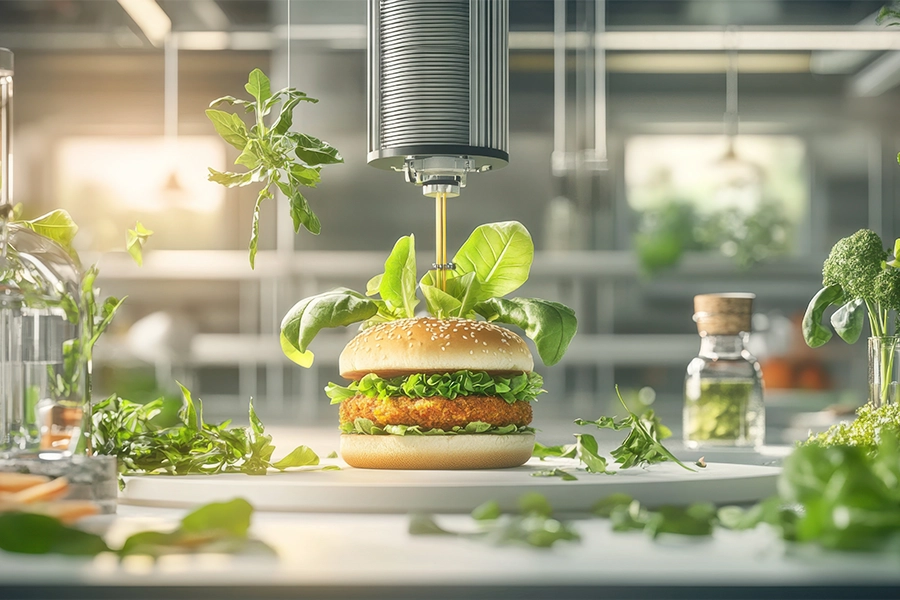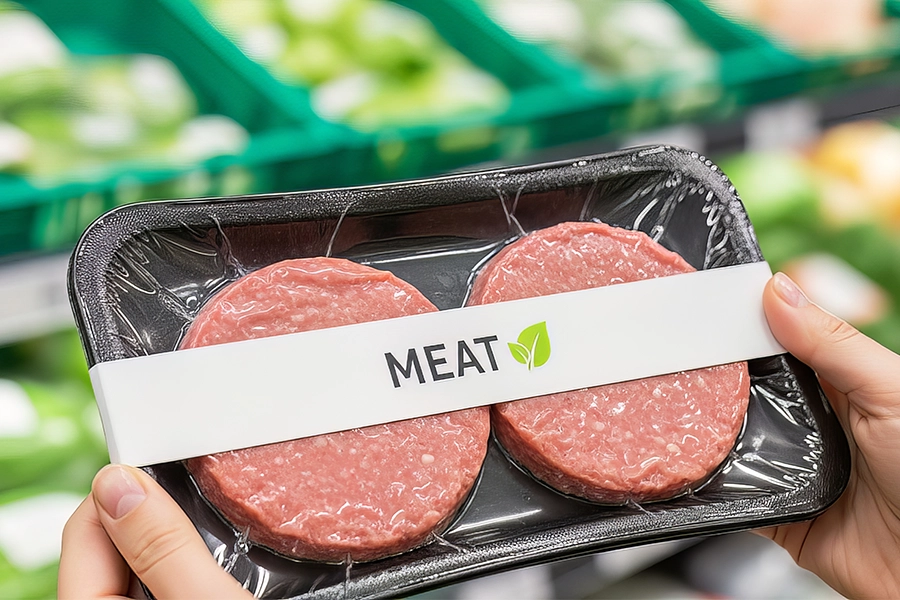Plant-based flavors shift toward science-backed masking, fermentation & sustainable design
Key takeaways
- Taste remains the biggest hurdle for plant-based foods, pushing companies beyond protein innovation toward science-driven solutions.
- Flavor innovation is tackling off-notes, texture, and creaminess by neutralizing bitterness at the molecular level.
- Sustainability and partnerships are shaping the next wave, with companies embedding carbon and waste reduction into flavor design.
Taste remains the breaking point for plant-based foods. Protein options keep multiplying, but improving taste continues to be a central challenge for the industry. Companies are moving past protein innovation alone and putting taste at the center — masking bitterness, recreating creaminess, adding savory depth, and baking sustainability into flavor development.
“Poor taste is still the category’s biggest hurdle,” says Melanie Luangrath, senior director new business development at dsm-firmenich. “If plant-based products are not delicious, they won’t make it into the basket twice.”
That urgency is driving different solutions. dsm-firmenich is turning to receptor science, Givaudan to sensory mapping, Biospringer to yeast fermentation, and Sensient to a mix of botanical innovation and sustainable design principles. We speak to each of these major players about their latest advances in plant-based food flavors.
Tackling off-notes with receptor-based tools
At dsm-firmenich, one approach has been pairing a rapeseed protein isolate with ModulaSense, a masking system designed to hit bitterness, floral notes, and astringency at the receptor level.
“ModulaSense works at the molecular level,” Luangrath explains. “It targets the receptors that pick up unpleasant notes while preserving the protein’s natural character. The idea is not to cover over the problem, but to neutralize it at its root.”

She says the synergy is intentional. “The protein delivers nutrition and functionality. ModulaSense makes sure those benefits aren’t lost to taste issues.”
Trials across Europe and North America have shown better consumer scores for recipes combining the two, compared to protein-only bases. Lighter and fruitier profiles — normally tricky in high-protein formats — are now possible, Luangrath adds.
The company’s developers start with what turns consumers off. “We identify the drivers of dislike in each matrix,” she says. “Once those compounds are reduced, you have a cleaner canvas to build on.”
Closing the sensory gap
Givaudan calls the issue the “sensory gap.”
“Replicating the taste and texture of meat and dairy with plant-based ingredients remains one of the biggest challenges,” says Catherine Bayard, global product manager at the company’s Plant Attitude platform. “Poor taste and texture are among the top reasons consumers stop buying plant-based meat.”
She points to research showing that a third of European consumers still resist trying plant-based meat at all. Among those who did, many stopped because of poor flavor, texture, or a sense of over-processing.
The company uses its Sense It sensory language to map how proteins taste and feel, and then builds flavor systems from there. For meat alternatives, the focus is juiciness, flavor release, and cooking performance. For dairy, it’s recreating creaminess. “People expect a yogurt to be silky, a creamer to be rich, a cheddar to bite,” Bayard says.
She notes that consumer testing is constant. “We run co-creation sessions, preference mapping, and we’re using digital simulations to see how ingredients interact. It shortens the distance between what consumers want and what reaches the market.” From masking bitterness to boosting creaminess, food innovators are using receptor science, fermentation, and sensory mapping to close the taste gap in plant-based foods.
From masking bitterness to boosting creaminess, food innovators are using receptor science, fermentation, and sensory mapping to close the taste gap in plant-based foods.
Fermentation as flavor infrastructure
Biospringer, part of Lesaffre, primarily uses fermentation to develop its flavors.
“Plant-based foods face a dual challenge: delivering nutrition and indulgence,” says Sophie Laugier, global digital marketing officer. “Protein sources like soy, pea, or fava often bring bitterness, astringency or ‘green’ notes that turn consumers away. Our yeast-based solutions target those issues head-on.”
Springer Mask 102 works on bitter receptors directly, reducing off-flavors in applications from meat substitutes to shakes. “That’s crucial when protein levels are high,” Laugier says.
Maxarome Prime, on the other hand, boosts umami intensity. “It survives processing and reheating,” she notes. “Soups, sauces, frozen meals — they all benefit from a savory backbone that lasts.”
For creaminess and fattiness perception, Biospringer points to Springer Cocoon. “It’s about kokumi, the roundness that makes dairy-free products indulgent,” Laugier says.
She adds that the company’s clean-tasting yeast protein gives formulators a way to add nutrition without earthy or beany notes.
Broadening consumer drivers
Sensient Technologies sees broader cultural and social factors pushing flavor demand forward.
“Health is often the first driver, with plant-based products marketed as cleaner and linked to wellness,” says Nandrianina Raboanason, marketing manager at Sensient Flavors & Extracts. “But there are also dietary restrictions, allergies, veganism, and flexitarianism. And then environmental and ethical concerns — plant-based fits better into sustainable and animal-friendly consumption.”
Social forces matter too. “Social media, influencers and documentaries have made plant-based more visible and aspirational,” Raboanason adds. “Clean eating, wellness, mindful consumption — these frames are shaping what flavors people expect.”
She points to adoption in new areas. “Vegan is no longer niche. Consumers are choosing plant-based coffees, and snacks are catching up. But plant proteins can have strong tastes, which makes transition difficult. That’s where our taste solutions step in.” Sustainability meets flavor: companies are weaving carbon reduction, clean-label design, and yeast-based solutions into the next generation of plant-based taste.
Sustainability meets flavor: companies are weaving carbon reduction, clean-label design, and yeast-based solutions into the next generation of plant-based taste.
Sustainability as a design principle
Sensient says it treats sustainability as a core driver in flavor design.
“Our program has five pillars: decarbonization, water stewardship, waste reduction, sustainable supply chain, and sustainable product design,” Raboanason says.
The fifth pillar is central to innovation. “Every new project follows a checklist to cut carbon, reduce water and waste, and use ethically sourced materials. Last year we achieved the goal of applying this checklist to 100% of new developments.”
“We are calculating product carbon footprints, with a target of covering products that represent 30% of revenue by 2028. It strengthens our portfolio and keeps responsibility at the core of what we do.”
Partnerships and open platforms
Partnerships are another shared theme.
Givaudan highlights its Protein Hubs and the Cultured Hub with Bühler and Migros in Switzerland, which supports scale-up for fermented and hybrid proteins.
Biospringer points to its role in the Flavor and Texture Consortium. “We’re helping to identify the origins of off-notes and validating yeast-based ways to reduce them,” says Laugier.
And Luangrath emphasizes co-development with customers. “It’s not just about supplying an ingredient,” she says. “It’s about making sure protein, processing and flavor systems all align.”
Looking ahead
“The next wave of plant-based products must win in every dimension — taste, texture, nutrition, transparency and sustainability,” says Luangrath.
Bayard stresses novelty as well as authenticity. “Consumers want variety. They’re not only looking for mimicry of meat — they want new experiences they’ll remember.”
Laugier says fermentation will stay at the heart of Biospringer’s work: “We’re investing in a steady pipeline to make plant-based foods tastier, healthier, and more sustainable.”
Raboanason expects adoption to spread further. “Health and environmental awareness are no longer niche. We’re seeing movement in beverages, snacks, and savory categories. The challenge is making the taste good enough that consumers adapt quickly.”
Closing the taste gap that keeps plant-based products from mainstream acceptance will continue to rely on these main pathways — receptor masking, sensory mapping, yeast fermentation, sustainable design.
Innova Market Insights has found that 30% of global consumers cite a lack of taste or flavor as a negative characteristic they associate with plant-based, vegetarian, or vegan foods. But, at the same time, the global market researcher says there is low product launch activity across flavor categories in these markets.














